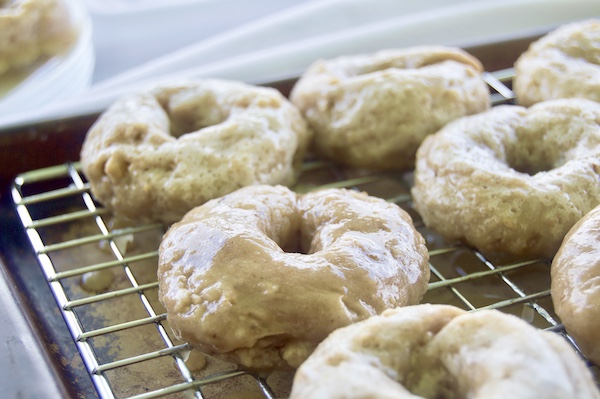Syrian doughnuts can be made with a hole, or not. And they are topped with lemon or another type of glaze or syrup, rather than having a jelly filling. (photo from vegankinda.wordpress.com)
One of the things I have enjoyed the most as a food writer is learning the different customs of Jews from around the world. When it comes to doughnuts, all the communities make a dough dessert fried in oil, but there are differences.
Dov Noy, who was an Israeli folklorist and ethnologist, related a Bukhharian fable, which says that the first sufganiya was a sweet given to Adam and Eve as compensation after their expulsion from the Garden of Eden. He says the word sufganiya comes from the Hebrew word sof (meaning end), gan (meaning garden) and Ya (meaning G-d). Thus, the word means, the end of G-d’s garden. According to Noy, this fable was created at the beginning of the 20th century, since sufganiya was a new Hebrew word coined by pioneers.
Some consider sufganiyot, which means sponge-like, to be reminiscent of the sweet, spongy cookies that have been popular along the Mediterranean since the time of the Maccabees. Hebrew dictionaries say the word actually comes from the Greek word sufgan, meaning puffed and fried.
A few months ago, I happened to stop at a vendor in Machane Yehuda, the Jewish market where I shop and lead weekly walks, to ask about a pastry he was selling. He told me it was shvinze. Many years ago, a neighbour had given me her mother’s receipt for shvinze and I share it with you here.
I’ve also included a recipe from another neighbour, who made a similar type of dessert that she learned from her mother, who came from Syria. And the third recipe is for traditional Israeli doughnuts that can be filled or left plain. Talia was 5-and-a-half years old when she gave me this recipe – today, she is the mother of four, a tour guide married to a photographer, and living in the scene of the Chanukah story, Modi’in.
MOROCCAN SHVINZE
1 2/3 tbsp yeast
1/4 cup lukewarm water
a pinch salt
4 cups flour
oil
honey or confectioners’ sugar
- Place yeast in a small bowl with water. Place flour in another bowl. After the yeast swells, add to the flour. Add salt, then knead into an elastic dough.
- Place oil in a deep pot. Wet hands, take a piece of dough and shape it into a circle. Punch a hole in the centre, then drop the dough into oil. Brown it on both sides. Drain on paper towels.
- Serve with honey or confectioners’ sugar.
SYRIAN ZINGOLE
2 tsp yeast
a few spoons warm water
2 cups flour
1 1/2 cups water
oil
icing:
1 cup sugar
1 cup water
1 1/2 tbsp lemon juice
- Place yeast in a small bowl. Add a few spoons of warm water to dissolve.
- Place flour in another bowl. Add yeast and then more water to make a liquidy batter.
- Heat oil in a deep pot. Spoon batter into pan like pancakes. Fry until brown on both sides. Drain on paper towels.
- Combine sugar, water and lemon juice in a saucepan. Cook until sugar dissolves.
- Dip each pancake in sauce, then place on a serving platter.
TALIA’S SUFGANIYOT FOR JUNIOR COOKS
3 1/2 cups flour
1 1/2 cups plain yogurt
2 eggs
2 tbsp sugar
a pinch salt
1/2 tsp vanilla
oil
- In a mixing bowl, supervised by an adult, combine flour, yogurt, sugar and salt. Add eggs and vanilla and blend.
- Heat oil in a deep pot (with an adult’s help). Drop dough by tablespoon into oil. Fry until brown on both sides. Drain on paper towels.
- When cool to the touch, fill, using a tube or a large syringe, with your favourite jelly. Roll in confectioners’ sugar.
Sybil Kaplan is a journalist, editor of nine kosher cookbooks (working on a 10th) and a food writer living in Jerusalem. She leads English-language Shuk Walks in Machane Yehuda.

